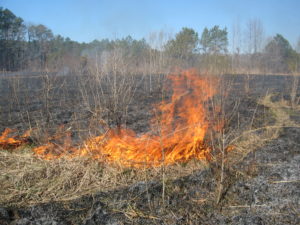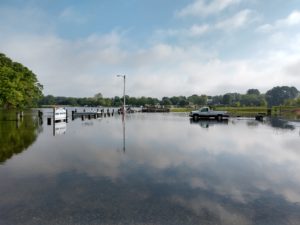The United States Department of Defense Prepares for Climate Change
As the climate warms, ice caps melt, sea levels rise, and the weather becomes more unstable, the United States Department of Defense is preparing for climate change. They are acknowledging that climate change is occurring and identifying approaches to mitigate the challenges it represents to their mission.
The department is considering the impacts climate change will have in two ways. First, they are looking at how global security will be impacted. Second, the threat to the nation’s defense infrastructure is being reviewed.
Read More: State Wildlife Agencies Have to Evolve
Even if they are not as advanced in their climate change approach as one would like, the Defense Department’s approach to climate change puts them ahead of Trump’s Environmental Protection Agency’s work on climate change.
Caveat lector: This post is not presented to prioritize the effects of climate change on national security above those on the environment and wildlife. Rather, like our previous post on the economic impacts of climate change, it is offered with the hope that readers might be able to use this information to convince climate skeptics that we must act on climate change.
Climate Change Impacts Global Security:
Consider the following scenario: A drought of historic proportions occurs in a highly volatile region. The years long drought, acerbated by climate change, makes hundreds of thousands of people food insecure. These people migrate throughout the unstable region and beyond. The mix becomes volatile and a civil war erupts with global consequences.
Sadly, we do not need to consider the above scenario. We need to, instead, study its real impact on millions of lives and global security. This drought scenario played out with devastating impacts in Syria over the last decade and a half.

Wildfires present the greatest immediate threat to military installations. Enhanced risk from wildfires is one of the Department of Defense’s prime concerns about climate change. Photo by Chris Pupke
Like numerous other studies of the origins of the Syrian Civil War, experts in the March 2015 “Proceedings of the National Academy of Sciences of the United States of America” came to the following conclusion:
“ There is evidence that the 2007-2010 drought contributed to the conflict in Syria. It was the worst drought in the instrumental record, causing widespread crop failure and a mass migration of farming families to urban centers. Century-long observed trends in precipitation, temperature, and sea-level pressure, supported by climate model results, strongly suggest that anthropogenic forcing has increased the probability of severe and persistence droughts in this region, and made the occurrence of a 3-year drought as severe as that of 2007-2010 2 to 3 times more likely than by natural variability alone. We conclude that human influences on the climate system are implicated in the current Syrian conflict.” Colin P. Kelley et. al. “Climate Change in the Fertile Crescent and Implications of the Recent Syrian Drought”; https://www.pnas.org/content/112/11/3241
Other reports note the significance of the crop failure which includes up to 75% total crop failure and 85% loss of livestock in some areas of Syria. These losses led to the loss of the entire livelihood of more than 800,000 Syrians and helped drive two to three million into extreme poverty.

Sunny day flooding in the Chesapeake Bay Region has become a regular issue, particularly at the US Naval Academy and at the Norfolk Navy Base. Photo by Chris Pupke
Drought is just one way climate change can impact global security. In the U.S. Naval Institute’s October 2017 Proceedings (Vol. 143 No. 10), Commander Timothy McGeehan, USN, states: “Rising global temperatures, changing precipitation patterns, climbing sea levels, and extreme weather events will intensify the challenges of global instability, hunger, poverty, and conflict. They will likely lead to food and water shortages, pandemic disease, disputes over refugees and resources, and destruction by natural disasters in regions across the globe.” McGeehan notes that climate change is a “’threat multiplier’ that exacerbates preexisting issues and contributes to both intra- and interstate conflict.
The Defense Department notes that weather patterns over the Mediterranean Sea, flooding in Guam and melting ice cap in the Arctic are already impacting its ability to accomplish its mission. These climate-related issues will only increase if we fail to address the man-made causes of climate change.
Climate Change and the Department of Defense Infrastructure:
In its January 2019 “Report on Effects of a Changing Climate to the Department of Defense”, Defense highlights the threats to the nation’s military bases. As one would imagine, naval installations are threatened by sea-level rise. However, the most threatened bases are Air Force Bases.

Air Force Bases are among the most vulnerable military installations. The increased threat of wildfire due to climate change presents a real concern for these installations. The Department of Defense is preparing for climate change. Photo by Chris Pupke
Many naval installations are threatened by rising sea levels including those near San Diego, CA, Norfolk, VA, and Key West, FL. The installations are flooding on a more regular basis. Even on sunny days, high tides are infiltrating the bases.
However, the most endangered military installations according to the report are several Air Force Bases. The existential threat to these facilities is wildfire. Consider a wildfire like the one that hit Paradise, California last fall. Like the devasting effect that fire had on the town, a wildfire could level a military installation. Those air force bases in areas of high wildfire risk include Beale AFB in California, Greeley ANGS in Colorado and Hood AFB in Utah. Hood is considered the defense installation most at risk from climate change.
Unfortunately, the Pentagon tried to bury the report and was shamed into publicly releasing it only after environmental groups and the press called for its release. Additionally, the report failed to evaluate all military installations. For example, no marine bases were included in the findings, including Camp Lejeune which sustained significant damage from Hurricane Florence in September 2018.
Furthermore, the report fails to note that Tyndall Air Force Base is threatened by enhanced cyclonic activity. And, sure enough, as the report was being finalized, Tyndall was obliterated by Hurricane Michael on October 2018. This led to Sen Jack Reed (D-RI) to state that the report “carries about as much value as a phonebook.”
Clearly, the Department of Defense needs to do a better job. Indeed, the U.S. Government Accountability Office found in November 2017 that: “(t)he expected impacts of weather effects associated with climate change pose operation and budgetary risks to overseas infrastructure according to the Department of Defense but DOD does not consistently track the impacts’ estimated costs. Operation risks (including interruptions to training, testing, and missions) and budgetary risks (including costs of repairing damages) are linked to these impacts.”
And yet, with all these abundant flaws, the Department of Defense outpaces the EPA on addressing climate change.
EPA on Climate Change Under Trump:
The Environmental Protection Agency during the Trump Administration has not just consistently failed to address climate change, Trump’s EPA has actively fought to promote policies that will accelerate climate change. Rather than repeat the long list of Trump’s EPA policies that undermine efforts to address climate change, I offer the following two quotes from former EPA administrators who served in Republican Administrations. These quotes were given during testimony before the House Committee on Energy & Commerce on June 11, 2019.
“Perhaps the most discouraging –and dangerous—fallout of the approach of the current (Trump) administration at EPA is the abandonment of any concern about the threat posed by global climate change.” -Christine Todd Whitman EPA Administrator 2001-2003 under President George W. Bush
“I believe there is a need for rigorous oversight by the committee of the (EPA’s) capacity for sound decisions.” -Lee M. Thomas EPA Administrator 1985-1989 under President Ronald Reagan
If the EPA cannot make sound decisions and has abandoned fighting climate change, we cannot have any faith that the Trump Administration will address climate change effectively.
Biophilia Helping Wildlife Fight Climate Change:
While Biophilia Foundation is not aiding the Department of Defense to address the threats climate change has on global security and defense infrastructure, we are working to address climate change as a threat to wildlife. A 2018 report from the Intergovernmental Science-Policy Platform on Biodiversity and Ecosystem Services states that climate change is one of the top threats to biodiversity.
Biophilia is partnering with groups across the continent to restore and protect habitat for wildlife. In addition to the wildlife benefits, this habitat can also help mitigate the negative impacts of climate change. These groups preserve habitat, restore wetlands and plant trees. Wetlands are great carbon sinks. Trees help clean the air of carbon dioxide. Wildlife habitat store immense amounts of carbon but if that habitat is lost it could release significant amounts of carbon. While, reducing carbon outputs especially from energy production is key, protecting and restoring wildlife habitat can provide important benefits in the fight against climate change.
We invite you to join us in supporting these organizations that restore and protect wildlife habitat and fight climate change. This work can beneficial impacts for all of society.
Sources:
https://climateandsecurity.org/2012/02/29/syria-climate-change-drought-and-social-unrest/
“Climate Change Adaptation: DOD Needs to Better Incorporate Adaptation Into Planning and Collaboration at Overseas Installations”; United States Government Accountability Office; GAO-18-206; November 2017
Erian, Wadid et. al.; “Drought Vulnerability in the Arab Region: Special Case Study Syria”; United Nations: Office for Disaster Risk Reduction; 2010
Office of the Under Secretary of Defense for Acquisition and Sustainment; “Report on Effects of a Changing Climate to the Department of Defense”; Department of Defense; January 2019
https://www.pnas.org/content/112/11/3241
http://www.thenewhumanitarian.org/feature/2009/09/02/drought-driving-farmers-cities
https://www.usni.org/magazines/proceedings/2017/october/war-plan-orange-climate-change

Recent Comments